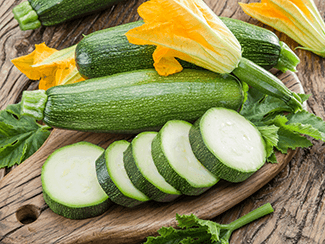GROWING YOUR OWN ZUCCHINI
If spending a lot of time at home has inspired you to cook more than usual, take the next step and grow your own food. Home-grown food is economical, plus you know what’s in and on it.
August is the time to plant zucchini (so is March). Like all summer squash, zucchini is nutrient-rich and contains a bounty of natural antioxidants and minerals. From zoodles, bread, salads, and side dishes, zucchini is a versatile fruit. Yes, zucchini is a fruit, not a vegetable.

Optimal Planting Conditions
Optimal conditions for planting zucchini include the right location, proper soil preparation, and favorable temperatures. According to Laurel Reader, Master Gardener, The University of Arizona Cooperative Extension, temperatures over 70 degrees Fahrenheit are favorable for growth and development. Because sunlight is essential, locate the zucchini garden in an area that receives six to 10 hours of sun daily. Zucchini thrives in the extreme summer temperatures.
While pre-planted, prepared beds purchased from a nursery are an option, you will have more choices if you start from seed. Plus, harvesting from scratch is a reward itself. You only need a few seeds to grow three or four plants that will feed a small family. Save the rest of the seeds for planting in March and the next few years. Label and keep them in the refrigerator. They will retain their viability for up to four years.
Plant seeds in one inch of light-textured, well-drained soil. When planted in compost-rich soil where nutrients are released slowly, additional fertilizers may not be required. An organic liquid fertilizer such as liquid seaweed may be applied at two to three-week intervals where the soil isn’t as fertile. Avoid high-nitrogen fertilizers; because they encourage more leaves and stems to grow.
Group two to three plants close together so there will be more flowers opening which significantly improves pollination. Squash plants may produce more males early in the season. The females will show up. Female zucchini blossoms are on short stems directly attached to the fruit and have a small bulbous area — the unfertilized zucchini. Male blossoms are produced on long, thin stalks and have a stamen in the center of the flower.

You can help pollinate!
Early in the morning before the flowers close, dust pollen from the male flowers onto the female flowers. After pollination, pick the male flowers, dip them in batter, and fry them for a tasty treat.
Adequate soil moisture is crucial, especially during flowering and fruit development. Soil should remain moist, not soggy between watering. Slowly water the soil, not the leaves. Soil-borne diseases can arise if water splashes from the soil on the leaves. Reader suggests watering deeply (two to three feet) two to three times a week in the summer (once a week for March planting). Mulch heavily with organic material to help maintain and moderate soil moisture. Foliage may appear to be wilting during the day. That’s okay. As evening approaches, they’ll perk up.
Dealing With Pests & Bacteria
Aphids, spider mites, squash vine borers, and whiteflies can ruin your zucchini. Planting nasturtium before the zucchini reduces aphids. In the mornings, spray both sides of the leaves with insecticidal soap, such as Bonide’s Captain Jack’s Deadbug Brew. It will kill those pests.
Watch for bacterial wilt, downy mildew, powdery mildew, and viruses. Test for bacterial wilt by cutting the wilted stem and touching the knife tip to the sap. If it is milky and sticky, the plant is infected and needs to be removed. Bacterial wilt, mildews, and most viruses can be controlled or prevented with good cultural practices. Keep the garden clean and free of weeds and debris. Prevent mildew with proper watering and good air circulation.
Keep critters out by installing a chicken wire around the garden.
Harvest
Harvest the fruit when they are roughly six to eight inches long and one and a half to three inches in diameter. Using pruners, scissors, or a knife, cut off the stem about one to two inches from the body of the fruit. Pulling zucchini off the plant will damage the entire plant and the roots. Keep zucchini picked, or the fruit production will slow, which can help if you have more zucchini than you can eat or give away.
Freshly harvested zucchini can be refrigerated up to two weeks. Freeze unused portions by shredding unpeeled zucchini. Drain in a colander, pat dry with a paper towel to remove moisture. Place in freezer bags and seal tightly. Frozen zucchini can last three months.
Find terrific zucchini recipes at FillYourPlate.org and tips at University of Arizona Cooperative Extension.
###
Photo Credit
- Shutterstock
























